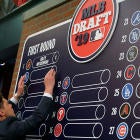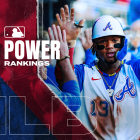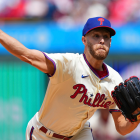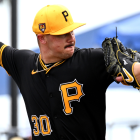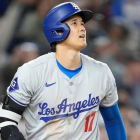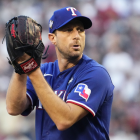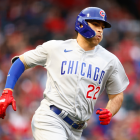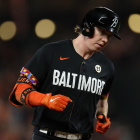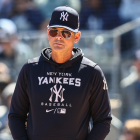Major League Baseball's 2019 draft began Monday night from MLB Network's Studio 42 in Secaucus, N.J. In an expected move, the Orioles drafted switch-hitting catcher Adley Rutschman with the first overall pick. Bobby Witt Jr. (Royals), Andrew Vaughn (White Sox), J.J. Bleday (Marlins) and Riley Greene (Tigers) rounded out the draft's top five picks. We have analysis of each first-round selection as well as takeaways from Day 1 and Day 2 of the draft.
The draft wraps up Wednesday with rounds 11-40. We have information for how to follow the rest of the draft as well as 10 things to know about baseball's 40-round selection process below.
• Dates: Monday, June 3 - Wednesday, June 5
• Day 3 start time: 12 p.m. ET
• Streaming: MLB.com
Here are 10 more things you need to know about the MLB draft.
1. It is 40 rounds over three days
The first two rounds go Monday night. There are actually 78 picks and we'll get to why here in a second.
The time between picks in the first round, per MLB, is "three to four minutes." The rest of the first day, teams have one minute to pick.
Tuesday, the draft resumes at 1 p.m. ET. All day, teams will have one minute between picks and it's rounds 3-10.
Wednesday, rounds 11-40 take place, starting at noon ET and there is no time between selections. Teams make their picks through a rapid-fire conference call. By this time, each team is generally locked on a specific player per round based upon extensive scouting, so it's really not a big deal to have no time between picks.
2. It includes competitive balance rounds and FA compensation
As noted, there are 78 picks through the first two rounds instead of 60 (two for each MLB team).
First up, if a team that receives revenue sharing and lost a player who declined a qualifying offer and signed for more than $50 million in free agency, it gets a compensatory pick after the first round. The only two free agents here came from the same team, as the Diamondbacks lost Patrick Corbin and A.J. Pollock. So they'll get two immediately after the first round.
Next, there's competitive balance round A (after first round) and then after the second round it's competitive balance round B. Here's how MLB describes this:
All teams that have either one of the 10 smallest markets or 10 smallest revenue pools receive an additional pick at the end of the first or second round. In 2017, six picks were assigned between the first and second rounds based on a formula that considers winning percentage and revenue. The remaining eight eligible teams received a supplemental selection between the second and third rounds. The groups of teams alternate between the two rounds each year. In 2018, there were eight Comp Round A picks and six in Round B. In 2019, there will be six Comp Round A picks and eight in Round B.
The final first-day pick is No. 78, which is a compensation pick to the Dodgers for losing Yasmani Grandal. Obviously the Dodgers don't receive revenue sharing but they also didn't exceed the luxury tax.
For those wondering about Bryce Harper -- the only player who declined the qualifying offer and signed for over $50 million that we haven't yet mentioned -- the Nationals get a pick after the fourth round, as they were over the luxury tax last year.
We've got the rest of the draft order here. Here is Mike Axisa's last mock draft.
3. Teams can pass on picks without penalty
Not every team will want to bother to go through the paperwork, negotiation and everything else that goes along with drafting a player in certain rounds, notably those toward the end of the draft. As such, teams can simply just pass in any given round without penalty.
4. The Orioles picked first for the second time in history
The Orioles last had the top overall pick in the draft in 1989, when they took right-handed starting pitcher Ben McDonald out of LSU. That really has no bearing on their pick of Rutschman, but it's a tidbit nonetheless.
5. The D-Backs have a lot of early picks
Between free agency, competitive balance and all that good stuff, there is an imbalance in picks early in the draft. The big winner this year is the Diamondbacks, who lost several quality free agents and got a competitive-balance pick (and didn't sign last year's first rounder -- we'll get to that).
As such, the Diamondbacks have picks: 16, 26, 33, 34, 56, 74 and 75.
At seven of the top 75 picks, that's easily MLB's biggest volume haul on the first day.
6. So do the Pirates and Rays
They aren't exactly in the Diamondbacks' area, but the Pirates and Rays each have four picks on the first day.
Pirates: 18, 37, 57, 72
Rays: 22, 36, 40, 61
7. This isn't like the NFL or NBA Draft at all
First off, players don't declare for the draft. Here is the eligibility requirement:
Players must be a resident of the United States (U.S. territories, such as Puerto Rico, apply) or Canada to be eligible for the draft. Players who have graduated high school but not attended college are eligible for the draft, as are those who have completed at least one year of junior college. Players attending four-year colleges are eligible to be drafted upon completing their junior year or turning 21 years old.
And, again, players don't "enter" or "declare" the draft. Everyone meeting those requirements is eligible to be drafted. You can make the arguement it's a much better system. You don't get players declaring or trying to figure out where they might get picked. They just either get picked and decide if they want to sign or don't get picked and go on with their baseball lives in whatever fashion they see fit.
Further, getting to Major League Baseball from the draft isn't just joining the team, even for first rounders. There's Rookie Ball, Short Season leagues, Low-A, Class-A, Class A-Advanced (or High-A), Double-A and Triple-A in the minors before the majors and that isn't even including things like instructionals, winter leagues or anything else players need to go through in order to prove themselves ready for the majors. The list of players in recent years to go straight to the majors without playing in the minors is incredibly short.
As such ...
8. Teams don't generally draft for immediate needs
As I said above, it would be folly to view the MLB Draft like the NBA or NFL.
Sure, a team like the Orioles might say they want to rebuild around high-upside starting pitching, for example, and take the best high school arm. The Cubs during their rebuild focused on taking college hitters in the first round (Kris Bryant, Kyle Schwarber, Ian Happ), for example.
It's just that the mindset from those other drafts could cause a fan -- who doesn't realize how this draft works -- of a team needing bullpen help to see a college outfielder drafted in the first round to say something like "we don't need an outfielder, we need a closer!"
Yeah, that's not how this works.
The most advanced players are being taken by teams that are years away from contending. Take the Bryant example. He was taken in 2013 and didn't see the majors until 2015 after 180 minor-league games.
Last year's No. 1 overall pick, Casey Mize, came out of Auburn as the best player in college baseball. He's in Double-A right now (Tigers' system). He is dominating and we'll see him next year, maybe even later this year, but he's the exception, not the rule.
Very rarely do we see any of these picks within the next year, so think future instead of present.
9. Lots of players won't sign
Given all the circumstances mentioned above, a very large number of players drafted will not sign. We'll see high school players who want to play in college for their own reasons (whether it's to increase draft stock, the college experience for the education), college juniors who believe they can greatly increase their draft stock (though juniors have a lot more leverage than seniors in negotiating deals) and junior college players decide to go play elsewhere.
Some might think most of the players who don't sign are from the later rounds, but we'll see early round players neglect to sign. In fact, three first-rounders last year did not sign. When that happens, the drafting team gets a compensation pick the following year one spot later.
A good recent example of this is when the 2014 first overall pick Brady Aiken was found to have an issue with his elbow and didn't sign with the Astros. The following year, the Astros got the second overall pick and took Alex Bregman. That one turned out OK, huh? To reiterate above, despite being a very advanced prospect out of LSU, he played in 146 minor-league games before his MLB debut.
10. It'll be years before we know who did well
Taking in everything above about how the draft is more a long-term project here than other sports, this all lines up. We could go back to, say, 2011 and see Gerrit Cole, Trevor Bauer, Dylan Bundy, Anthony Rendon, Archie Bradley, Francisco Lindor, Javier Baez, George Springer, Brandon Nimmo, Jose Fernandez (sigh, RIP), C.J. Cron, Sonny Gray, Kolten Wong, Joe Panik and others in an utterly loaded first round and realize that Danny Hultzen (2nd overall) and Bubba Starling (5th) were bad picks.
To do it now, though? It's far too early to know how everything is going to go down. So-called "can't miss" picks sometimes miss. "Reach" picks sometimes end up working out.













